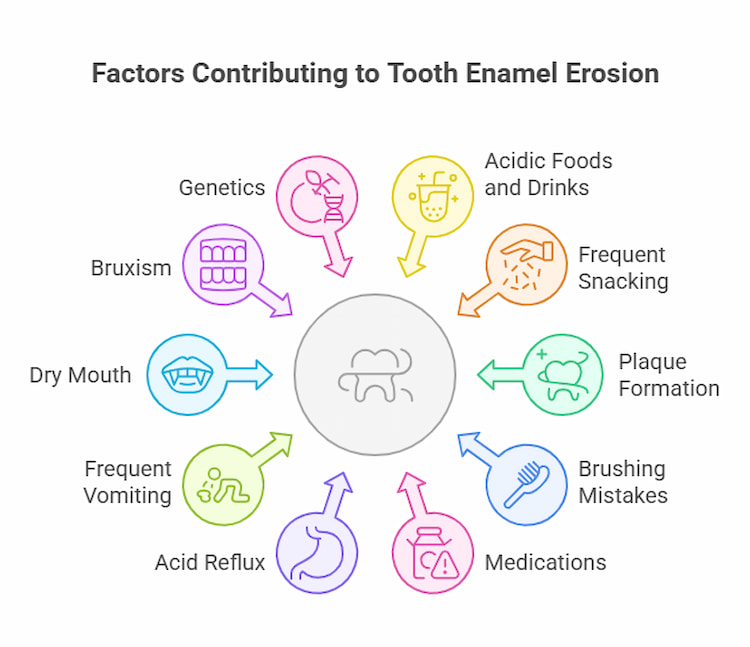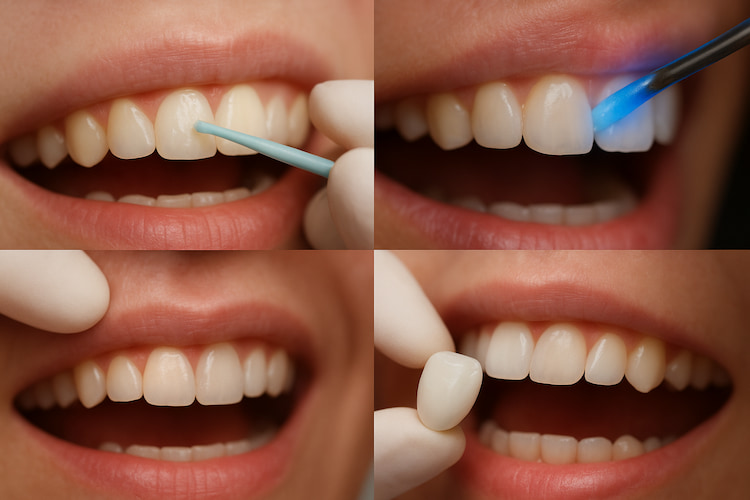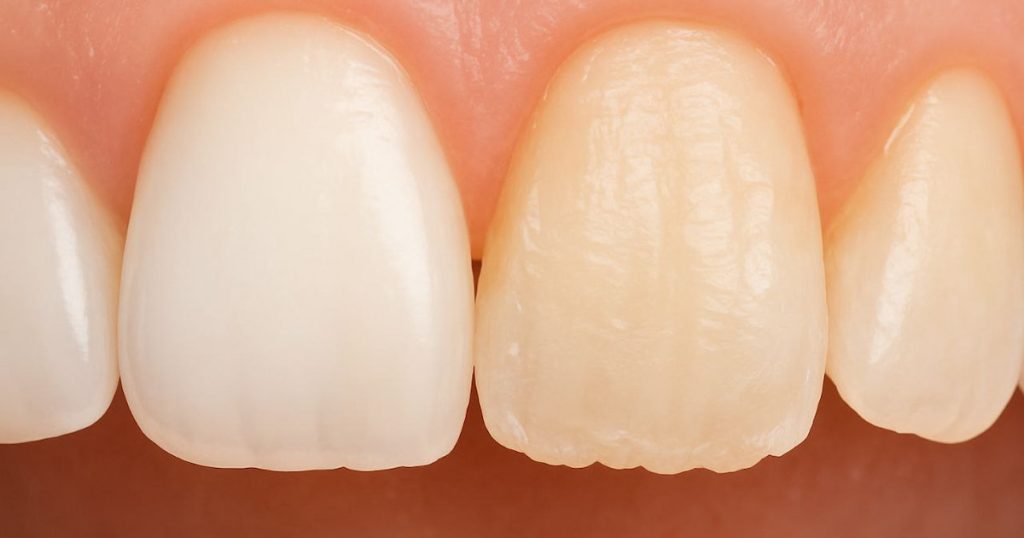One of the most common yet often overlooked problems is tooth enamel erosion. Because enamel is the outer protective layer of your teeth, once it starts wearing away, the underlying tooth structure becomes exposed and vulnerable. Understanding what enamel erosion is, the causes of it, like acidic foods and drinks, its symptoms, such as tooth sensitivity and discoloration, and how you can treat or prevent it is essential for keeping your smile healthy. Regular preventive dental exams can help detect enamel erosion early.
That’s why we gathered this guide to help you with early detection and informed actions.
What is Tooth Enamel Erosion?
Tooth enamel is the thin but tough outer coating that shields your teeth from daily wear and tear. Unlike bone, enamel has no living cells, which means it cannot regenerate once lost.
Tooth enamel erosion occurs when acids gradually dissolve this protective layer. One thing to keep in mind is that this process is different from cavities (tooth decay), which involve bacterial activity. Erosion is purely chemical, and it weakens the teeth. Therefore, teeth become more prone to sensitivity, discoloration, and breakage.
Causes of Tooth Enamel Erosion
Enamel erosion doesn’t happen overnight. It’s the result of repeated acid exposure that softens and wears down the enamel surface. There’s a list of common factors below.
Acidic Foods and Drinks
Consuming sodas, citrus fruits, fruit juices, sports drinks, and energy drinks regularly can expose your teeth to acid. Even sugar-free sodas are acidic enough to weaken enamel over time. If these are part of your daily routine, try to enjoy them with meals to reduce direct acid contact.
Frequent Snacking or Sipping
Taking small sips of acidic beverages throughout the day or holding them in your mouth for too long increases exposure. Constant eating would make your teeth more in contact with food particles and acids. This repeated contact creates more opportunity for enamel erosion to occur.
Plaque Formation
Foods that are high in sugar and starch can lead to plaque formation. Plaque bacteria break down these foods and release acids that attack enamel. Without regular brushing, flossing, and professional cleanings, this acid exposure continues and weakens the teeth, which leads to an increased risk of both erosion and cavities.
Brushing Mistakes
Using a toothbrush with hard bristles or applying too much force can wear down enamel, especially along the gum line. Also, brushing just right after consuming acidic foods or drinks can spread acids across the enamel surface, and this maximizes the risk of erosion.
Overdoing Teeth whitening
Whitening treatments are usually safe because the concentrations of chemicals are low. However, can teeth whitening damage your enamel if it’s done incorrectly or too often? It’s always best to follow your dentist’s guidance to avoid disturbing protective enamel and increasing sensitivity.
Medications and Supplements
Chewable vitamin C, aspirin, and some liquid medications can be acidic. Over time, repeated exposure can erode enamel. If you rely on these regularly, ask your doctor or dentist about alternatives or ways to reduce their impact, like swallowing with plenty of water.
Acid Reflux (GERD)
Stomach acids that frequently flow back into the mouth can be even more damaging to enamel than food or drink acids. If acid reflux is left untreated, it can cause serious erosion. Managing GERD through diet changes, medication, or medical advice is essential to protect both your overall health and your teeth.
Frequent Vomiting
Vomiting repeatedly due to conditions such as bulimia, pregnancy-related morning sickness, or chronic gastrointestinal issues brings highly corrosive stomach acid into the mouth. This exposure quickly wears away enamel. Getting help from your doctor is important not only for dental protection but also for overall health.
Dry Mouth
Saliva is helpful for neutralizing acids. When saliva flow is reduced, due to medications, dehydration, or medical conditions, your teeth lose this protective barrier. A consistently dry mouth increases the chance of enamel erosion and tooth decay.
Bruxism (Teeth Grinding)
Grinding or clenching your teeth places constant physical stress on the enamel. Over time, this pressure wears down the surface, making teeth more vulnerable to sensitivity and erosion. Your dentist may recommend a night guard to protect your teeth if bruxism is a problem.
Genetics
Some people genetically have thinner enamel or structural weaknesses that make their teeth more prone to erosion. You can’t change genetics, but being aware of this risk allows you to be extra careful with your diet, hygiene, and preventive dental care.

What to Do Immediately After Enamel Is Exposed to Acid
If you’ve just had something acidic like soda, citrus juice, or an episode of reflux, your first instinct may be to brush right away. Avoid this because enamel that is softened by acid can be brushed away more easily. Instead:
- Rinse your mouth with plain water.
- Chew sugar-free gum to stimulate saliva.
- Wait at least 30 to 60 minutes before brushing.
- Use a fluoride toothpaste to help strengthen enamel when you brush.
Don’t Ignore the Early Signs of Enamel Erosion
At Pape Dental Centre, we’re here to help you protect your smile with personalized care, from preventive checkups to advanced treatments like dental bonding.
Schedule your appointment today and take the first step toward stronger, healthier teeth.
Symptoms of Tooth Enamel Erosion
In its early stages, enamel erosion may not cause noticeable symptoms, but as the condition progresses, you might experience:
| Tooth Sensitivity | Experiencing pain or discomfort when consuming hot, cold, sweet, or acidic foods and drinks. |
| Discoloration | Teeth may look yellow as the underlying dentin becomes more visible. |
| Rounded or Transparent Edges | The biting edges of front teeth can look worn down or see-through. |
| Chips and Cracks | Weakened enamel is more prone to breaking. |
| Cupping on Tooth Surfaces | Small dents may appear where enamel has worn away. |
Treatment for Tooth Enamel Erosion
According to NIH, the enamel is acellular and does not regenerate itself, unlike other biomineralized tissues such as bone. But dentists have effective ways to treat the problem and restore teeth’s function and appearance. Treatment depends on the severity of the erosion. Your dentist will evaluate your situation and suggest the most appropriate option, often combining treatments with preventive care to protect the remaining enamel.

Mild Enamel Erosion
In the early stages of enamel erosion, the damage is often limited to the outermost layer of enamel. At this point, the primary goal is to stop further damage and strengthen the existing enamel.
One of the most effective methods is fluoride treatments. Fluoride helps to remineralize the enamel, making it more resistant to acid attacks. This treatment is done by a dental professional and may involve fluoride varnishes or gels.
Note: It’s important to note that while fluoride can strengthen weakened enamel, it cannot reverse the erosion or regenerate lost enamel.
Moderate Enamel Erosion
As enamel erosion progresses, the damage becomes more apparent. You may notice increased tooth sensitivity, discoloration, and visible thinning of the enamel. At this stage, dental professionals may recommend restorative treatments to address the aesthetic and functional issues.
Professional teeth bonding is a common procedure used to restore the appearance of teeth affected by moderate erosion. It involves applying a tooth-colored resin to the eroded areas, which is then sculpted and hardened to match the natural shape of the tooth. Bonding not only improves the tooth’s appearance but also provides a protective layer over the remaining enamel.
Natural-looking porcelain veneers are another option for restoring teeth with moderate erosion. These are thin shells custom-made to fit over the front surface of the teeth, effectively masking discoloration and providing a durable, natural-looking finish. Veneers are particularly beneficial for patients seeking a more permanent solution for the appearance of teeth.
Severe Enamel Erosion
In cases of severe enamel erosion, the damage extends deeper into the tooth structure, potentially exposing the underlying dentin. This can lead to significant sensitivity and increased risk of cavities.
Long-lasting dental crowns are often recommended for teeth with extensive erosion. A crown is a cap that covers the entire tooth, restoring its shape, size, and strength. Crowns are particularly useful for back teeth that endure significant chewing forces.
In situations where the tooth structure is severely damaged, emergency root canal therapy may be necessary. This procedure involves removing the damaged or infected pulp from inside the tooth, cleaning the root canals, and sealing them. After a root canal, a crown is typically placed to protect the tooth and restore its function.
Tips to Prevent Enamel Erosion

The best way to manage enamel erosion is through preventive care. Taking care of your teeth not only keeps your enamel healthy, but it also saves you from further and more complicated procedures. Here are practical habits that help protect your teeth:
- Maintain Good Oral Hygiene: Brush twice using a soft-bristle toothbrush daily with fluoride toothpaste and floss once a day. Fluoride treatment strengthens enamel and helps resist acid attacks.
- Adjust Your Diet: Limit frequent exposure to acidic foods and drinks. If you do consume them, have them with meals rather than sipping throughout the day. Using a straw to drink them and rinsing with water afterward also helps.
- Stay Hydrated: Drink plenty of water to keep saliva flowing, and avoid excessive caffeine or alcohol that can lead to dry mouth.
- Choose Protective Products: Ask your dentist about fluoride varnishes or remineralizing pastes for extra protection.
- Address Medical Causes: If you suffer from acid reflux or frequent vomiting, work with your doctor to manage these conditions.
Read more: if you want to know more about expert-advised oral care habits, check out the guide.
When to See a Dentist
You should schedule a dental exam if you experience sensitivity that lasts more than a week, notice your teeth becoming yellowed or thinner, observe chips, cracks, or visible indentations, or have ongoing issues with acid reflux or frequent vomiting.
Regular checkups allow your dentist to detect enamel erosion early, provide fluoride treatments, and recommend personalized preventive strategies to protect your teeth and prevent further damage.
Keep Your Smile Strong by Preventing Tooth Enamel Erosion
Tooth enamel erosion is a slow but serious process that can lead to tooth sensitivity, cosmetic changes, and structural damage if left unchecked. The good news is that with awareness, lifestyle adjustments, and professional preventive care, you can protect your teeth and maintain a healthy smile.
You may also be exploring other dental treatments to keep your smile healthy. At Pape Dental Centre, we offer a full range of care from routine dental cleaning that keeps your teeth and gums healthy, to advanced root canal treatment that stops cavities from spreading.
FAQ
-
What can cause tooth enamel erosion?
Tooth enamel erosion can result from frequent exposure to acids in foods and drinks, acid reflux, certain medications, teeth grinding, or even brushing too hard over time.
-
Can a dentist fix enamel loss?
Dentists can’t regrow enamel once it’s lost, but they can treat the damage with options like fluoride treatments, dental bonding, or veneers to protect teeth and restore appearance.
-
What does tooth enamel erosion look like?
It often shows as increased tooth sensitivity, yellowing, rounded or rough edges, and, in more advanced cases, cracks, chips, or holes on the surface of the teeth.
-
How to reverse enamel erosion?
Enamel loss can’t be reversed because there are no living cells in enamel, but you can slow or stop the process by improving oral hygiene, reducing acidic food and drink, and using dentist-recommended fluoride treatments.
Have you noticed tooth sensitivity, yellowing, or other signs that could point to enamel erosion? Share how you recognized the problem and what helped you take action. Your experience could encourage others to seek dental care sooner.


